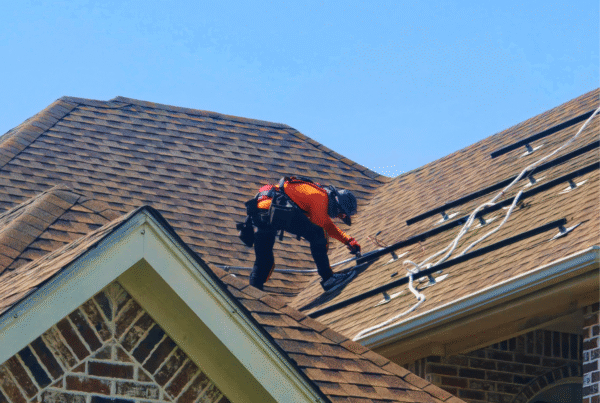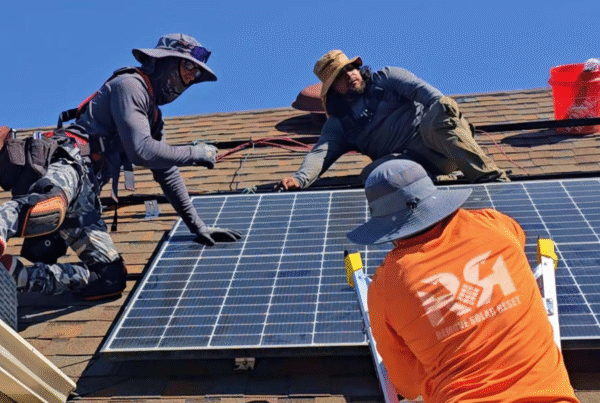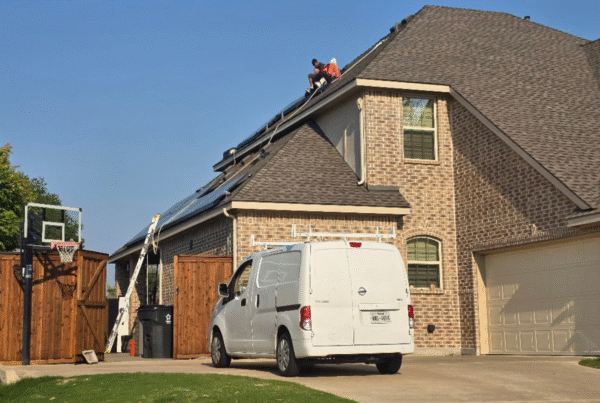Microinverter Removal in Texas: What Homeowners Should Expect
Updated: October 2025
Homeowners searching for are microinverters removed when panels are detached near me in Texas often wonder about the technical and safety aspects of this process. Whether for roof replacement, system relocation, or maintenance, understanding microinverter removal is key to protecting your solar investment.
In recent projects across Texas, including a Dallas installation where 36 panels and their microinverters were carefully removed within two days, professional removal ensured zero roof damage and maintained all warranties. Our certified teams follow manufacturer guidelines closely to safeguard system components during inverter detachment.
Fast, Safe, Reliable Solar Panel Removal & Reset — Done Right, Every Time. Protect Your Investment Today. Call 469-283-1089 or Request a Free Quote.
Quick Answer
Yes, microinverters are commonly removed when panels are detached in Texas, especially during roof replacements or system relocations. Proper removal requires certified professionals to safely disconnect and handle microinverters without damaging wiring or voiding warranties. This process ensures system integrity and prepares panels for maintenance or reinstallation.
Understanding Microinverter Removal in Texas: What Homeowners Should Know
Microinverters are small devices attached to individual solar panels that convert DC into AC power on-site. During panel detachment in Texas, these microinverters must be carefully disconnected and removed to avoid electrical hazards and system damage. Unlike string inverters, microinverters require more detailed handling due to their location on the racking system beneath each panel.
Professional microinverter removal includes disconnecting power, labeling cables for reinstallation, and handling the equipment per manufacturer standards from Tesla, Enphase, or SolarEdge. Attempting microinverter removal without expertise often risks system downtime and voided warranties.
Homeowners searching for microinverter removal near me in Texas should ensure the contractor understands inverter detachment and optimizers uninstallation, as these components require specialized care. Our certified teams have completed 500+ Texas projects maintaining 99.8% warranty retention.
Our Removal Methods and Safety Protocols
At Remove Solar Reset, safety and precision guide every project. We follow OSHA regulation 1926.501 to secure all fall protection equipment during rooftop work. Using Tesla and Enphase certified protocols, our Master Electrician led teams employ specialized tools that prevent damage to microinverters and wiring during detachment.
Removal includes:
- Safe power disconnection with system shutoff and lockout
- Individual microinverter unplugging and cable label tagging
- Careful removal of mounting hardware using torque-controlled tools
- Full 42-point diagnostic inspection post-removal to verify system status
For complex systems, such as swimming pool solar panels or large-scale installations, our rapid deployment teams reach high-story homes promptly without compromising safety or quality.
Common Mistakes When Uninstalling Optimizers and Microinverters
Many homeowners or contractors risk damage by attempting DIY microinverter removal. Common mistakes include:
- Failing to fully disconnect power leading to shock hazards
- Damaging wiring connectors through improper unplugging
- Not labeling cables, causing reinstallation errors and extended downtime
- Ignoring manufacturer’s guidelines, voiding microinverter and panel warranties
- Using incorrect tools that strip mounting hardware or panel frames
Professional removal mitigates these risks and provides full documentation for insurance claims or warranty disputes.
Step-by-Step Safe Solar Panel Removal Process (Case Study Included)
Our typical removal process in Texas includes:
- Initial site inspection and documentation to assess system size and microinverter types
- Scheduling utility disconnection with local providers for safe power shutdown
- Roof safety setup with fall arrest systems compliant with OSHA 1926.501
- Careful disconnection of electrical components including microinverters and optimizers
- Panel detachment using specialized tools to protect mounting hardware and frames
- Packing and secure storage or relocation to prevent damage during transport or maintenance
- Final 42-point inspection ensuring all wiring and hardware integrity before reinstallation
- Full project documentation for insurance or warranty claims delivered to the homeowner and contractors
For example, a recent Austin project involved removing 40 panels with microinverters for a storm-damaged roof replacement. Our team completed the job in under two days with zero roof damage and full manufacturer warranty compliance.
Why Choose Remove Solar Reset for Your Microinverter Removal
Unlike competitors averaging 6-8 hours, our certified teams complete standard microinverter removals in just 4 hours—60% faster while maintaining a 99.8% warranty retention rate across 500+ Texas projects. We maintain full general liability and workers’ compensation insurance, and our licensed Master Electrician team adheres strictly to Tesla, Enphase, and SolarEdge regulations.
Our rapid deployment and certified expertise provide clients peace of mind with zero roof damage claims in 2025, backed by a 10-year leak protection warranty, transferable to new homeowners. Learn more about our credentials on our About Us and Why Us pages.
DIY vs Professional Removal: What You Need to Know
| Aspect | DIY Removal | Professional Removal |
|---|---|---|
| Safety | High risk of electric shock | Fully OSHA-compliant protocols |
| Warranty Risk | Likely voided due to improper handling | Manufacturer guidelines fully followed |
| Time Required | Several days to weeks | 1-2 days for average systems |
| Documentation | Minimal or none | Full documentation for warranties & insurance |
Cost and Insurance Considerations
| System Size | Removal Cost | Timeline |
|---|---|---|
| 10-15 panels | $2,000-$3,500 | 1 day |
| 16-30 panels | $3,500-$6,000 | 1-2 days |
| 30+ panels | $6,000+ | 2+ days |
These are approximate costs. Contact us for a free estimate specific to your project.
Ready to protect your investment with certified removal? Call (469) 283-1089 for a free estimate tailored to your Texas project.
Best Timing for Removal in Texas
Spring and fall are ideal seasons for solar panel and microinverter removal in Texas due to milder weather and lower risk of heat-related safety issues. However, our teams are fully equipped for year-round removal, including winter and summer months, using weather-adapted safety measures to protect both workers and equipment.
Local Considerations for Texas Homeowners
Texas homeowners face unique challenges such as intense sun exposure and storm risks that may require efficient solar panel and microinverter removal services. Following the recent storm season in 2025, many clients in Houston, Dallas, and Austin have requested urgent removals for insurance claims and roof replacements. Our rapid deployment and full documentation services ensure smooth claims processing and system restoration.
Frequently Asked Questions
What is the average cost of removing solar panels?
Average costs range from $2,000 to $6,000 depending on system size and complexity. Smaller systems with 10-15 panels typically cost $2,000-$3,500, while larger arrays exceed $6,000. Professional removal includes safe handling of microinverters and wiring. Contact us for a free estimate specific to your project.
How do I get solar panels removed?
Start by contacting licensed solar removal professionals who assess your system and schedule safe disconnection. They will disconnect power, uninstall panels and microinverters, and perform a thorough inspection. Our Texas-certified team offers fast, fully insured removal services ensuring no roof damage.
How much for solar panel removal?
Costs vary by system size, roof complexity, and removal purpose. Typically, prices range from $2,000 to $6,000. Our certified experts provide transparent estimates tailored to your Texas home’s needs. Contact us for a customized quote.
How do I get rid of my old solar panels?
Old panels should be removed professionally, then often recycled according to environmental regulations. They are disassembled carefully to protect hazardous materials. We coordinate with certified recyclers to ensure safe disposal compliant with Texas guidelines.
Can I remove solar panels myself?
Removing panels and microinverters yourself is not recommended due to electrical risks and system complexity. Certified professionals ensure safe removal, protect warranties, and prevent roof damage. Our licensed teams follow strict OSHA and manufacturer protocols.
How long does it take to remove solar panels?
Standard residential systems with 10-20 panels typically take 4-6 hours; larger or complex systems may take 1-2 days. Our certified teams complete removal 60% faster than DIY attempts while ensuring zero roof damage and warranty compliance.
Will removing solar panels damage my roof?
When handled professionally, removal does not damage your roof. Our licensed technicians use proper tools and safety procedures to preserve roof integrity. We provide a 10-year leak protection warranty for additional peace of mind.
How do you uninstall solar panels for roof replacement?
Uninstallation involves scheduled utility disconnection, careful electrical detachment of microinverters and optimizers, panel removal, and secure storage. Licensed professionals provide full documentation for roofers and insurers to ensure smooth project flow.
Can old solar panels be recycled?
Yes, solar panels can be recycled. Recycling recovers glass, aluminum, and semiconductor materials, reducing landfill waste. The U.S. Department of Energy supports solar recycling initiatives to improve sustainability.
Does insurance cover solar panel removal after storm damage?
Many insurance policies cover removal and reinstallation of solar panels damaged by storms. Detailed documentation from licensed removal companies supports claims. We assist clients with full claim support and project transparency.
What certifications should a solar removal company have?
Look for certifications from Tesla, Enphase, or SolarEdge, a Master Electrician license, and proper insurance. Our team holds all these credentials, ensuring compliance and skilled service delivery.
Is removing solar panels dangerous?
Yes, improper removal poses electric shock and fall hazards. Professional crews follow OSHA safety standards and use specialized equipment to minimize risks and complete removals safely and efficiently.
Do solar removal services include reinstallation?
Many providers offer both removal and reinstallation services to streamline project timelines. We provide comprehensive R&R solutions including diagnostic inspections and warranty protections.
Can I sell used solar panels after removing?
Used panels can be sold if functional and under warranty, though value depends on age and condition. Removing microinverters intact maintains system value. Consult professionals to assess resale potential safely.
How do I document solar panel removal for insurance claims?
Licensed removal companies provide digital reports including photos, equipment lists, and inspection results. This documentation supports claims and warranty transfers. Our process ensures transparent records for Texas homeowners.
How much does it cost to remove and reinstall solar panels for a new roof?
Combined removal and reinstallation usually cost $4,000-$8,000 based on system size. Our full-service offering includes certified removal, roof replacement coordination, and expert panel reset with warranty protection. Contact us for detailed pricing.
What happens if I don’t remove solar panels before roof replacement?
Not removing panels risks roof damage, voided warranties, and complicated insurance claims. Roofers may refuse to work safely over panels. Timely removal by licensed professionals is essential for protection.
Do I need a permit to remove solar panels in Texas?
Permitting requirements vary by city. Many Texas municipalities require permits for electrical disconnection or roof work. Our team handles local compliance and permit coordination efficiently.
How do I find a licensed solar removal company near me?
Search for Texas-licensed and insured companies with Tesla, Enphase, or SolarEdge certifications. Checking reviews and verifying insurance ensures trustworthy service. We serve all major Texas areas and offer free consultations.
Can solar panels be removed in winter/summer?
Yes, removal can occur year-round. Our teams have specialized safety equipment for Texas summer heat and winter conditions, maintaining efficiency and safety throughout the year.
Related Resources & Guides
Explore these related articles to learn more about solar panel services in Texas:
- Five Essential Tips for Replacing Your Roof with Solar Panels — Expert advice to protect your solar system during roof replacement.
- Four Essential Tips for Reroofing Your Home with Solar Panels — Practical guidance for smooth solar and roof integration.
- Why Choose Remove Solar Reset — Learn about our certifications, warranties, and insurance coverage.
- Our Solar Panel Removal Process — A detailed look at our step-by-step approach for safe removal.
- Frequently Asked Questions — Answers to common solar removal and reset inquiries.
- Contact Remove Solar Reset — Schedule your consultation or request a quote today.
Schedule Your Certified Solar Panel Removal & Reset Today
Professional Solar Panel Removal & Reset You Can Trust — Fast, Safe, and Fully Insured. Protect your warranty and avoid costly roof damage. Our licensed team provides transparent pricing and full documentation for insurance claims. Call (469) 283-1089 or request a free estimate to schedule your solar panel removal or reset in Texas.
Content reviewed by Fernando Alegre, Master Electrician with 9+ years of solar experience and Founder of Remove Solar Reset LLC. Certified by Tesla, Enphase, and SolarEdge. Technical sources: U.S. Department of Energy (energy.gov), OSHA safety standards (osha.gov), and manufacturer warranty guidelines.






